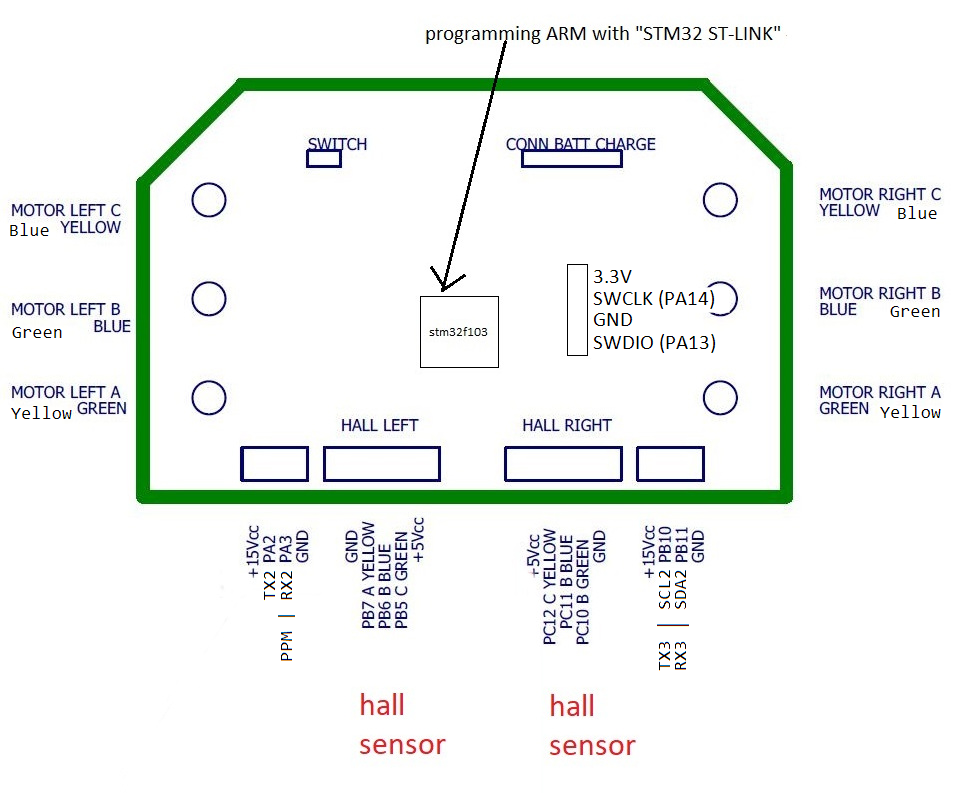50 lines
2.6 KiB
Markdown
50 lines
2.6 KiB
Markdown
# New Firmware! Now with actual current sensing!
|
|
This firmware is much better than the old one. tested up to 40A / 60V, no dead board so far :)
|
|
|
|
## hoverboard-firmware-hack
|
|
|
|
This repo contains open source firmware for generic Hoverboard Mainboards.
|
|
The firmware you can find here allows you to use your Hoverboard Hardware (like the Mainboard, Motors and Battery) for cool projects like driving armchairs, person-tracking transportation robots and every other application you can imagine that requires controlling the Motors.
|
|
|
|
---
|
|
|
|
#### Hardware
|
|

|
|
|
|
The original Hardware supports two 4-pin cables that originally were connected to the two sensor boards. They break out GND, 12/15V and USART2&3 of the Hoverboard mainboard.
|
|
Both USART2 & 3 can be used for UART and I2C, PA2&3 can be used as 12bit ADCs.
|
|
|
|
---
|
|
|
|
#### Flashing
|
|
To build the firmware, just type "make". Make sure you have specified your gcc-arm-none-eabi binary location in the Makefile. Right to the STM32, there is a debugging header with GND, 3V3, SWDIO and SWCLK. Connect these to your SWD programmer, like the ST-Link found on many STM devboards.
|
|
|
|
Make sure you hold the powerbutton or connect a jumper to the power button pins while flashing the firmware, as the STM might release the power latch and switches itself off during flashing.
|
|
|
|
To flash the STM32, use the ST-Flash utility (https://github.com/texane/stlink).
|
|
|
|
If you never flashed your mainboard before, the STM is probably locked. To unlock the flash, use the following OpenOCD command:
|
|
|
|
```
|
|
openocd -f interface/stlink-v2.cfg -f target/stm32f1x.cfg -c init -c "reset halt" -c "stm32f1x unlock 0"
|
|
```
|
|
Then you can simply flash the firmware:
|
|
```
|
|
st-flash --reset write build/hover.bin 0x8000000
|
|
```
|
|
|
|
---
|
|
#### Troubleshooting
|
|
First, check that power is connected and voltage is > 36V.
|
|
If the board draws more than 100mA in idle, it's probably broken.
|
|
|
|
If the motors do something, but don't rotate smooth and quietly, try to use an alternative phase mapping. Usually, color-correct mapping (blue to blue, green to green, yellow to yellow) works fine. However, some hoverboards have a different layout then others, and this might be the reason your motor isn't spinning.
|
|
|
|
---
|
|
|
|
|
|
#### Examples
|
|
|
|
Have a look at the config.h in the Inc directory. That's where you configure to firmware to match your project.
|
|
Currently supported: Wii Nunchuck, analog potentiometer and PPM signal from a RC remote.
|
|
If you need additional features like a boost button, have a look at the while(1) loop in the main.c
|